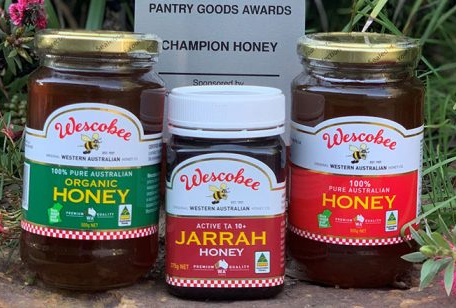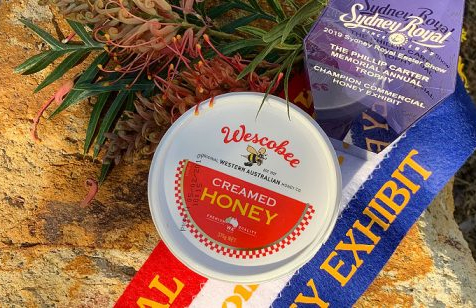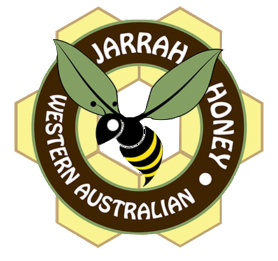A few words
About us
The question in most people’s minds when buying a different product is “What makes this product better than the one I already know?” Honey is no different.
So what sets Wescobee Honey apart?
The Wescobee Honey Company has been in operation since 1927. Today the company continues the long tradition established by its founders, in ensuring a quality honey product is maintained from point of production to the end consumer. Wescobee’s reputation for marketing a 100% pure quality Australian honey is well known in over fourteen countries around the world.
Wescobee honey is produced in the wild forest reserves of the South West and desert areas of Western Australia. These areas contain vast stands of Karri, Jarrah, Banksia, Heathland trees and shrubs. This region is ideal for the production of a 100% pure and natural honey due to a climate characterised by long sunny days and a crystal clear atmosphere aided by the strong cleansing Antarctic winds. This clean and unpolluted environment is free of fallout, acid rain and industrial pollutants.
Wescobee premium honey products are 100% pure and natural, containing:
No Additives
No Preservatives
No Added Sugars, Syrups or Extenders
No Artificial Flavourings
No Artificial Colourings
Wescobee honey is proud to produce just pure, natural 100% West Australian honey which is why Wescobee honey is in such demand. Such is the commitment to quality that Wescobee has become Quality Accredited under the International Standard of SQF 2000cm (compatible with ISO 9002), Organic Honey Packing Certified, HALAL Certified and Kosher. Additionally Wescobee has been accrediting each beekeeper supplier under the B-Qual certification system.
Around the world the apicultural industry suffers many diseases of the bees and hive. To control such diseases such as Varroa, European Foulbrood, Chalkbrood and Noseama, beekeepers feed and treat the bees with drugs and chemicals. Western Australia is unique in that it does not have these beehive diseases. This unique advantage results in a pesticide, drug and chemical free honey. Strict quarantine controls prevent honey or apiary products from entering Western Australia enabling us to protect our local industry from these diseases and keep the honey pure and natural.
Strategically Wescobee honey has other advantages. These include:
A Low Moisture Content
This is achieved by allowing the honey to fully ripen in the hive. The result is a dense honey having a moisture level of 17-18.5% (compared to other developing countries where 19.5-22% is common). The low moisture content prevents fermentation of the honey due to the wild yeasts interacting on the natural sugars. Additionally, high moisture honeys could indicate that it has been adulterated by the addition of water to the honey. Wescobee strictly monitors all honey moisture levels to ensure your product is the best that nature can provide.
Rich Dark Colour
For a long time the world market believed that only light coloured honey was best. Now research is showing that darker honeys contain a greater degree of minerals and trace elements essential for modern man and health. These darker honeys are prized among true honey eaters and the health food industry throughout the world. Wescobee honey is naturally rich in colour due to the soil, vegetation varieties and natural elements thereby giving the consumer these unique health benefits.
No Heat Damage During Processing or Packing
The application of heat to honey is to speed up the processing ability of honey. Internationally the test used to measure heat and age of honey is a HMF Test (Hydroxymethylfurfual). The world market is generally set to accept a level of 40mg/Kg. Wescobee honey consistently records a level well below this level – around half the international standard. This reflects in part, the care and attention given to our honey to give the consumer a product “just
as nature produces it.
Organic Status
Wescobee honey is wild harvested meeting International Organic Standards. Wescobee is certified for Organic packing.
Microbiological Status
Due to the strict health standards of Australian law and the Company itself, Wescobee markets honey that is low in microbiological organisms. This low microbiological factor found in Wescobee honey is critical to consumers and results in the natural anti-microbial properties remaining at a maximum level.
This is why Wescobee is able to guarantee that its premium honey products are 100% pure, natural and of the highest quality in the world.
HELP! My honey has crystalised!
Over time, many types of honey will granulate or crystallise. Crystallisation is a natural process that occurs with most honeys making the honey look cloudy, usually resulting in a separation of liquid on top and a more solid (crystallised) section below.
Depending upon the original nectar source, the crystallisation rate might differ from honey type to honey type. Crystallisation happens when glucose (one of 3 main sugars in honey) spontaneously precipitates out of the supersaturated honey solution. The glucose loses water and takes the form of a crystal. The crystals form a lattice, which immobilises other components of honey in a suspension thus creating the semi-solid state.
Many factors effect the crystallisation of honey; some batches never crystallise while other occur in a few days. Crystallisation can be stimulated by any small particles – dust, pollens, bits of very fine beeswax, propolis and air bubbles – that are present naturally in honey. These factors are also related to the type of honey and are influenced by how the honey is handled and processed.
Additionally the composition (in percentage terms) of the various sugars found across different honey floral sources also affects the rate of crystallisation.
Crystallised (or granulated) honey is just as safe to eat as non-granulated honey and can be easily restored to its natural state. Just gently warm the container of honey in hot water (but make sure no water gets into the honey, otherwise it will ferment). The crystals will slowly melt and the honey will re-liquefy easily, although each time it is re-heated the honey may granulate slightly quicker than before.
Wescobee is able to guarantee that its premium honey products contain only 100% pure and natural honey that’s been produced right here in Western Australia. Wescobee Honey contains: No Additives, No Preservatives, No Added Sugars, Syrups or Extenders, No Artificial Flavourings and No Artificial Colourings.
2019 : Year of Sweet Victory For Wescobee
2019 has been a great year for us and our AWARD WINNING Western Australian honey. We are buzzed to announce our latest sweet victory from the Royal Agricultural Society of Western Australia’s Food Awards.
We are thrilled to be awarded ‘Champion Honey’ through the following individual product awards:
GOLD for our Everyday Western Australian Honey
SILVER for our Certified Organic Western Australian Honey
BRONZE for our Jarrah Honey

These awards complement our Champion Commercial Honey Exhibit award from the Sydney Royal Easter Show’s National Honey Competition!
But we couldn’t have done this without the help of our skilled Beekeepers who supply us with the purest honey on the planet! A huge thank you our loyal customers for continuing to support Western Australian Beekeepers by choosing the original Western Australian honey, Wescobee!

Jarrah Honey Certification Launches
In a bid to protect one of our most iconic ‘active’ honeys, the Western Australian honey industry has joined together to launch the Certified Jarrah logo.
This wonderful initiative ensures when you pick up a product labelled as ‘Jarrah honey’, you can be sure you’re about to enjoy authentic Jarrah simply by looking for the logo. Any product that bears the logo indicates that the Jarrah honey has been sourced only from reputable Western Australian beekeepers who have been independently audited for Jarrah authenticity and traceability, and then tested and packed in accordance with the certification criteria.
We independently verify every batch of our Jarrah honey using Australia’s leading honey testing laboratories to ensure activity and quality. Our processes are also audited to ensure compliance with the certification criteria. Therefore, Wescobee Jarrah has proudly been awarded the Jarrah honey seal of authenticity to give you piece of mind you’re getting fair dinkum Jarrah!

Honey Bee Swarm Removals
The swarming process is part of the natural reproductive life cycle of honeybee colonies. Colonies are stimulated to swarm during spring when warmer weather, together with an abundance of nectar and pollen, provide ideal conditions for the colony to increase rapidly. The colony soon becomes overcrowded and is stimulated to reproduce by swarming.
The old queen, together with the field bees, leave the hive and cluster on a nearby object, usually a small tree or shrub. The swarm will often remain for a day or two while scout bees (worker bees) search for a new home, or it may move to another location.
In the parent colony, new virgin queens emerge from queen cells and fight to the death. The fittest queen will survive and usually mate, and continue to maintain the colony.
Although bees swarm mostly in the spring, from September to November, some colonies may swarm during the summer and autumn. Most swarms leave the colony or move to a new location between 10.00 am and 2.00 pm on warm sunny days. During wet weather a swarm may stay in its resting place for several days.
Swarms and people
Most people who are unfamiliar with honeybees have a natural fear of them when they occur in large numbers. But swarming bees are very docile and are not inclined to sting provided they are left alone and a few common sense precautions are taken.
Should a swarm decide to settle on your property:
- Keep children and pets inside for half an hour or so, until the flying bees have clustered on to a bush or other object.
- Once the swarm has formed a cluster, usually about the size of a football, and most of the bees have stopped flying, it is safe to be outside pursuing your usual activities.
- Keep clear of the swarm until you can arrange to have it removed.
- Always wear footwear to protect your feet in case the odd bee has settled on the ground
- DO NOT HOSE THE SWARM WITH WATER, THROW STONES AT IT, ATTEMPT TO SMOKE THE BEES YOURSELF OR TRY ENCOURAGE THE SWARM TO MOVE.
This will provoke the bees, and encourage them to sting in defence. Such actions will also make it more difficult for a beekeeper or licensed pest control operator to remove the swarm.
Removal of swarms in WA
When a swarm has settled on your property, the best course is to have it professionally removed. If you decide to do nothing the swarm may move to a new location or settle in the cavity wall of your house, an old drum, shed or a similar dark place, and establish a permanent nest, which can be expensive and more difficult to remove.
Generally, a swarming colony is not aggressive unless provoked. But at times swarms may become more aggressive due to adverse weather conditions or a scarcity of nectar and pollen. While local council advises exterminating the bees as the safest measure to avoid the likelihood of someone being harmed, we personally suggest referring the Western Australian Apiarists’ Society (WAAS)’s Swarm Catchers Contact List so that the bees survive. After all, we LOVE our beeutiful honey bees and want to protect them!
Swarm removals should always be carried out by either a licensed pest control operator or a beekeeper who is skilled in catching swarming bees. Please note that the WA Department of Agriculture does not remove swarms or exterminate nests of bees.
The Medicinal Property of WA Honey
Medicinal honey from Western Australia certified for antimicrobial benefits set to rival Manuka, written by Bridget Fitzgerald for ABC WA Country Hour. View original article.
Scientists have developed a process to certify West Australian honey with medicinal and antimicrobial properties, which will rival New Zealand’s famous Manuka honey.
The new certification process, developed by industry and food testing laboratory ChemCentre and funded by a $500,000 State Government grant, will now be able to authenticate WA honey with medicinal properties.
Honey that comes from jarrah and marri trees, which are unique to WA, are known as monofloral honeys and have been found to have some of the highest antimicrobial activity in the world.
Certification paves way for new marketing
But the WA honey industry had been unable to market these properties effectively because until now, it had no official certification process for monofloral honey.
ChemCentre principal food scientist Ken Dods said the certification would be able to test for and confirm the presence of antimicrobial activity in honey.
Mr Dods said certified honey would then have greater marketing value in export markets like China and Japan, where medicinal honey was in high demand.
He said his research had shown that jarrah and marri monofloral honeys had higher levels of antimicrobial activity than the famous Manuka honey from New Zealand.
“This certification process will protect and grow the WA honey industry,” he said.
The certification process will be launched at official opening of Baldivis honey producer Stephen Davies’s $2.5 million honey processing facility.
Mr Davies said the investment by State Government and industry into an authenticity certificate demonstrates the significant demand for WA honey in international markets.

